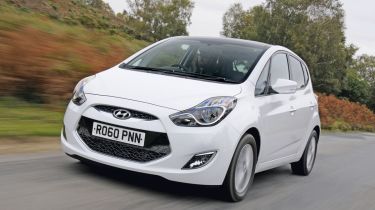Hyundai ix20
New supermini-MPV aims to continue brand’s recent success

The ix20 is another step forward for a company that’s going from strength to strength. The stylish new exterior and generous kit tally add to the sturdy build quality we’ve now come to expect from Hyundai. Offering huge space in a small package, this is a truly flexible family car – and with this ultra-efficient diesel engine, it’s also one of the greenest. This isn’t the best car to drive in its class, but that will be low down most buyers’ list of priorities, and it more than compensates in other areas.
Meet the Hyundai that’s dressed for success! The Korean company has enjoyed a boom in small car sales over the past few years, and the bold-looking ix20 supermini-MPV is another model that’s set to be a big hit in the UK.
It’s the second car to carry the manufacturer’s European family face and the ‘fluidic sculpture’ design language that debuted on the ix35 crossover this year.
Video: watch CarBuyer's video review of the Hyundai ix20
[[{"type":"media","view_mode":"content_narrow","fid":"68597","attributes":{"alt":"","class":"media-image"}}]]
The swept-back headlights and wide hexagonal grille translate well to the smaller body, and the sloping roof and narrow C-pillars ensure that the ix20 has a more dynamic stance than boxy rivals such as Citroen’s C3 Picasso. Chrome surrounds in the foglamps and headlights are a neat touch, as are the wraparound tail-lamps and roof spoiler.
Used - available now

2023 Audi
Q4 Sportback e-tron
54,526 milesAutomaticElectric
Cash £23,363
2022 Kia
Niro
18,315 milesAutomaticPetrol1.6L
Cash £17,900
2023 Nissan
Juke
40,858 milesManualPetrol1.0L
Cash £12,287
2022 Volkswagen
T-Roc
36,779 milesAutomaticPetrol1.5L
Cash £18,600Inside, the cabin is sturdy and robust, with a high-quality feel. The blade-shaped door handles, chunky gearstick and leather-wrapped steering wheel exude class, and there’s an asymmetric ‘eco’ pattern on
the seats and speaker covers to match the grille – the inspiration comes from the skeleton of a leaf, according to Hyundai.
The ix20 certainly has strong green credentials, with class-leading CO2 emissions figures of 114g/km. Fuel consumption is similarly low, with stop-start, low-rolling-resistance tyres and an alternator management system contributing to combined economy of 65.7mpg.
Behind the wheel, the ix20 is everything you’d expect from a supermini-MPV. The steering is set up for ease of use, rather than hard cornering. Although the suspension copes with swift changes of direction, the ix20 feels much more at home on the motorway, where its supple ride and refinement shine through.
This is the first car that Hyundai has developed and tested on British roads, so the right-hand-drive versions get a set-up designed specifically to cope with our broken tarmac.
While the 1.4-litre diesel model we drove delivers strong economy figures, it doesn’t impress as much as the rest of the car. The unit is sluggish below 1,700rpm, and becomes noisy and somewhat strained higher up the rev range.
The Hyundai is still more refined than its Kia Venga sister model, but unless you plan on regularly driving long distances or carrying particularly heavy loads, the similarly sized petrol version is the more civilised choice. That being the case, practicality is a top priority, and the firm is keen to point out that, despite its size, the ix20 has more luggage space than a Volvo V50 estate.
The rear seats offer three-way adjustability, and slide independently to make the roomy interior even more flexible. When folded flat, storage space expands to 1,486 litres – comfortably more than the
larger i30 hatchback.
Running costs have deliberately been kept as low as possible – services are needed only every 20,000 miles. There’s also an unlimited five-year warranty, and the ix20’s two insurance groups below most of its rivals.
Prices have yet to be confirmed, but the base-spec Classic should cost around £11,500, while the fully-loaded Style pictured here rises to just over £13,000.
So despite the recent injection of style in its cars, the ix20 ensures Hyundai still stands for value for money.







